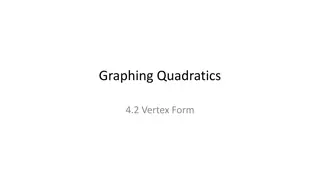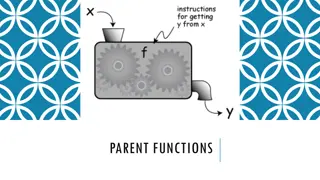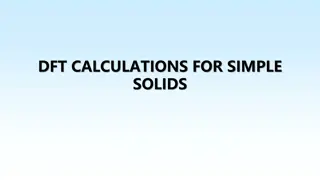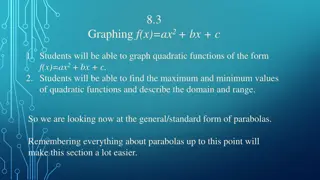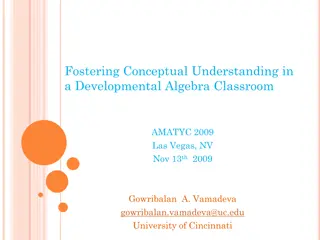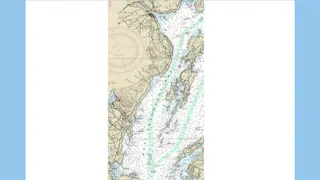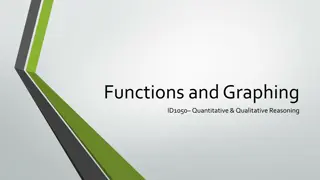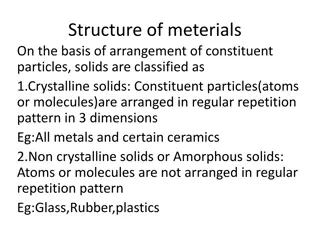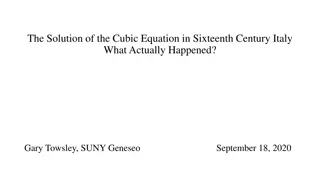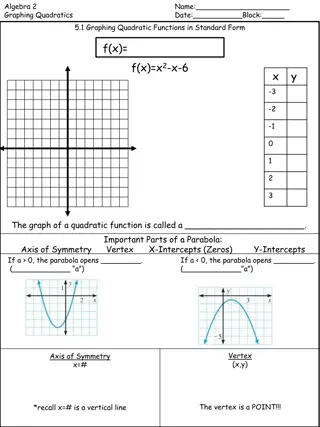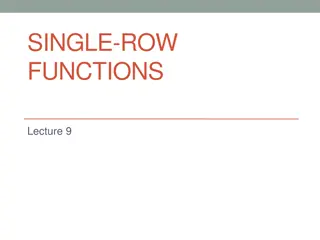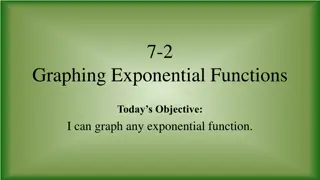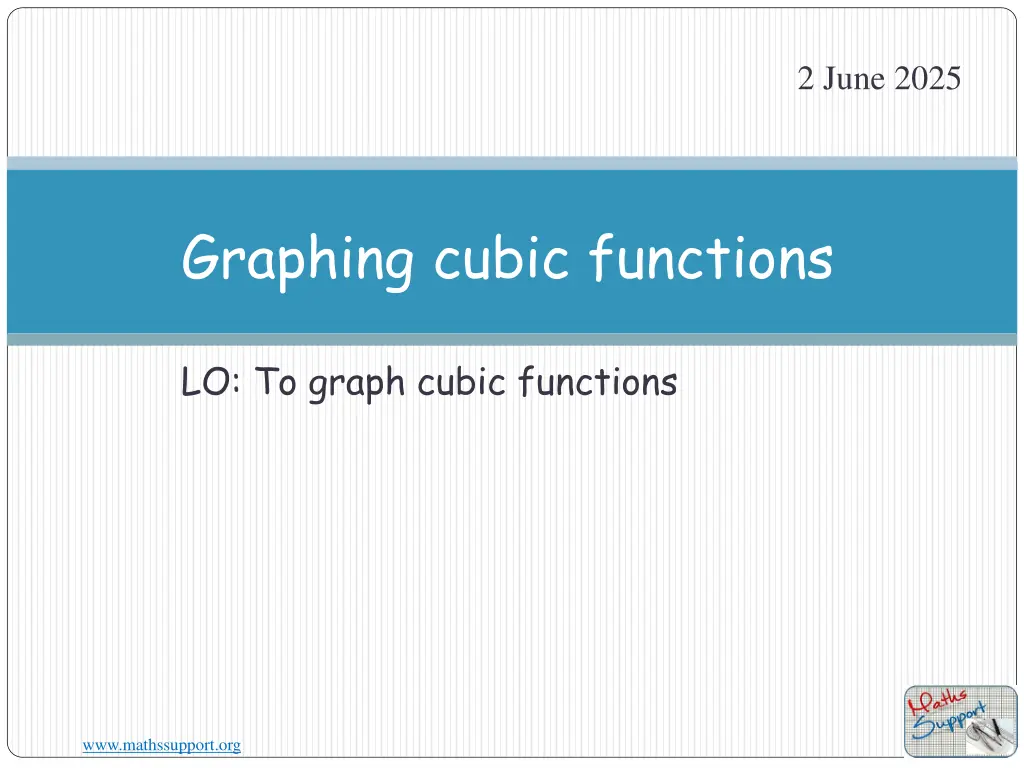
Graphing Cubic Functions: Understanding Transformations and Graphs
Explore the world of cubic functions through this guide, learning how to graph them and understand their transformations. Discover the effects of multiplying by constants, shifting the function, and more. Utilize visual aids to deepen your comprehension.
Uploaded on | 4 Views
Download Presentation

Please find below an Image/Link to download the presentation.
The content on the website is provided AS IS for your information and personal use only. It may not be sold, licensed, or shared on other websites without obtaining consent from the author. If you encounter any issues during the download, it is possible that the publisher has removed the file from their server.
You are allowed to download the files provided on this website for personal or commercial use, subject to the condition that they are used lawfully. All files are the property of their respective owners.
The content on the website is provided AS IS for your information and personal use only. It may not be sold, licensed, or shared on other websites without obtaining consent from the author.
E N D
Presentation Transcript
2 June 2025 Graphing cubic functions LO: To graph cubic functions www.mathssupport.org www.mathssupport.org
Cubic functions Introductory Questions What does the graph of a cubic function look like? How can we tell what it will do just by looking at the equation? What happens to f(x) = x as x orx - ? What is the effect of multiplying the function by a positive or negative constant? What might change if we shift the function left, right, up, or down? www.mathssupport.org www.mathssupport.org
Cubic functions The most basic cubic function is y = x3 function for values of x between 3 and 3. We graph the 3 27 2 1 0 1 2 3 x y = x3 8 1 0 1 8 27 y y Notice that: The graph is horizontal at (0, 0) As xgets very large and positive,y also gets very large and positive 40 30 20 10 We write: as x , y As xgets very small and negative,y also gets very small and negative We write: as x , y x 3 2 1 0 1 2 3 10 20 30 www.mathssupport.org www.mathssupport.org
Using a GDC, transformations of the cubic function We are going to investigate the effect of putting positive or a negative constant value (a) multiplying the function. f(x) = ? f(x) = ? f(x) = x3 Look at your graphs. What can you say about the cubic function after multiplying the function by a positive constant value? What is the effect of multiplying y by a positive constant a?Vertical stretch f(x) = 2x3 ???? ??? f(x) = x3 What is the effect of multiplying y by a negative constant? Vertical stretch and reflection over the x-axis For the curve y = ax3, What is the geometrical significance of a? ? ???? f(x) = ? f(x) = 2x3 f(x) = ??? www.mathssupport.org www.mathssupport.org
Using a GDC, transformations of the cubic function We are going to investigate the effect of adding a positive or a negative constant value (b and c) to the function. f(x) =3(x 2)3 f(x) = (x + 3)3 f(x) = x3 Look at your graphs. For the curve y = (x b)3 What is the geometrical significance of b? f(x) = (x 2)3 f(x) = 3(x 2)3 + 1 f(x) = x3 + 2 Look at your graphs. For the curve y = (x b)3 + c What is the geometrical significance of c? How the graph of y = a(x b)3 + c is obtained from the curve y = x3, f(x) =(x 1)3 + 3 f(x) = (x + 3)3 2 www.mathssupport.org www.mathssupport.org
Cubic functions Example 1: On the same set of axes, sketch the graph of y = x3and y = (x 2)3 1 y y Sketch the graph of y = x3 y = x3 8 6 All the points will be translated by two units to the right 4 2 And one unit downward x 3 2 1 0 1 2 3 2 4 We sketch the new graph 6 y = (x 2)3 1 8 www.mathssupport.org www.mathssupport.org
Graphs of cubic polynomials Cubic polynomials in factorized form Every real cubic polynomial can be categorized into one of four types In each case a , a 0, and the constants , and corresponds to zeros P(x) = a(x )(x )(x ) Three real, distinct zeros: Type 1: Try sketching graphs, giving values to a, , and Try positive and negative values for a. State the effect of changing both the size and sign of a. What is the geometrical significance of and ? The graph has three distinct x-intercepts corresponding to the three distinct zeros and ? x www.mathssupport.org www.mathssupport.org
Graphs of cubic polynomials Cubic polynomials in factorized form Every real cubic polynomial can be categorized into one of four types In each case a , a 0, and the constants , and corresponds to zeros P(x) = a(x )2(x ) Two real zeros, one repeated: Type 2: Try sketching graphs, giving values to a, and Try with positive and negative values for a. What is the geometrical significance ofthe square factor? For a cubic of the form P(x) = a(x )2(x ) where , the graph touches the x-axis at and cut it at x www.mathssupport.org www.mathssupport.org
Graphs of cubic polynomials Cubic polynomials in factorized form Every real cubic polynomial can be categorized into one of four types In each case a , a 0, and the constants , and corresponds to zeros P(x) = a(x )3 One real zero repeated three times: Type 3: Try sketching graphs, giving values to a, and Try with positive and negative values for a. What is the geometrical significance of ? For a cubic of the form P(x) = a(x )3 where the graph has only one x-intercept at x www.mathssupport.org www.mathssupport.org
Graphs of cubic polynomials Cubic polynomials in factorized form Every real cubic polynomial can be categorized into one of four types In each case a , a 0, and the constants , and corresponds to zeros P(x) = (x )(ax2+ bx + c), = b2 4ac < 0 Type 4:One real zero Try sketching graphs, giving values to a, and Try with values for a, bandc that give < 0 What is the significance of the quadratic factor which has no real zeros? For a cubic of the form P(x) = (x )(ax2+ bx + c), where < 0 There is only one x-intercept, x www.mathssupport.org www.mathssupport.org
Using axis intercepts Use the axes intercepts to sketch the graph of this function f(x) = 2(x + 3)(x + 1)(x 2) x-intercepts occur when y = 0 ( 3, 0) ( 1, 0) (2, 0) y-intercepts occur when x = 0 f(0) = 2(0 + 3)(0 + 1)(0 2) f(0) = 12 Asa > 0 the graph has this shape y y x 3 2 1 0 1 2 3 and the points are then joined together with a smooth curve. The shape of this graph is characteristic of a cubic function. 12 www.mathssupport.org www.mathssupport.org
Using axis intercepts Use the axes intercepts to sketch the graph of this function f(x) = x (x + 3)2 x-intercepts occur when y = 0 (0, 0) ( 3, 0) y-intercepts occur when x = 0 f(0) = 0(0 + 3)2 f(0) = 0 y y x As a < 0 the graph has this shape 3 2 1 0 1 2 3 and the points are then joined together with a smooth curve. www.mathssupport.org www.mathssupport.org
Finding a cubic function Find the equation of the cubic function with this graph The x-intercepts are 1, 2 , and 4 y y f(x) = a(x + 1)(x 2)(x 4) When x = 0 y = 8 x 4 2 1 0 8 = a(0 + 1)(0 2)(0 4) 8 = a(1)(2)(4) 8 = 8a a = 1 8 So, f(x) = (x + 1)(x 2)(x 4) www.mathssupport.org www.mathssupport.org
Finding a cubic function Find the equation of the cubic function with this graph The x-intercepts are -3, and touches at 1 f(x) = a(x + 3)(x 1)2 y y When x = 0 y = 6 6 6 = a(0 + 3)(0 1)2 6 = a(3)(1)2 x 3 1 0 6 = 3a a = 2 So, f(x) = 2(x + 3)(x 1)2 www.mathssupport.org www.mathssupport.org
Finding a cubic function Find the equation of the cubic function which has x-intercepts 1 and 3, y-intercept 9 and passes through ( 1, 8) The x-intercepts are 1 and 3, so (x 1) and (x 3) are linear factors We suppose the third factor is (ax + b) So, f(x) = (ax + b)(x 1)(x 3) When f( 1) = 8 When f(0) = 9 8 = ( 1a + 3)( 1 1)( 1 3) 8 = (3 a)( 2)( 4) 8 = (3 a)(8) 1 = 3 a a = 2 9 = (0a + b)(0 1)(0 3) 9 = b(-1)(-3) 9 = 3b b = 3 So, f(x) = (2x + 3)(x 1)(x 3) f(x) = 2x3 5x2 6x + 9 www.mathssupport.org www.mathssupport.org
Thank you for using resources from A close up of a cage Description automatically generated For more resources visit our website https://www.mathssupport.org If you have a special request, drop us an email info@mathssupport.org www.mathssupport.org www.mathssupport.org



